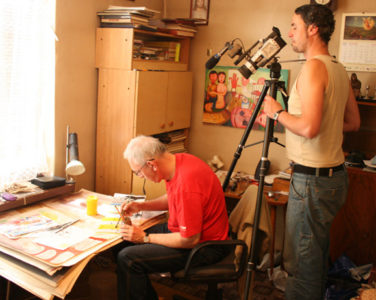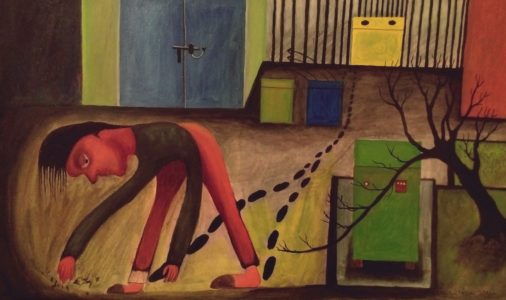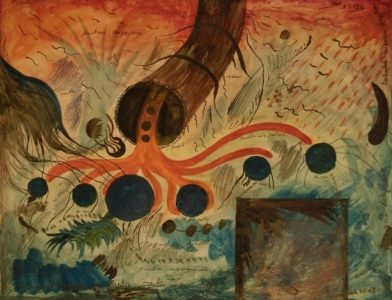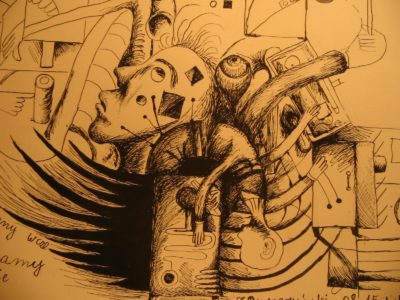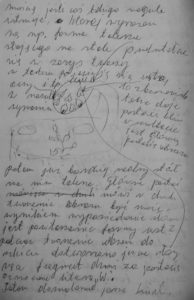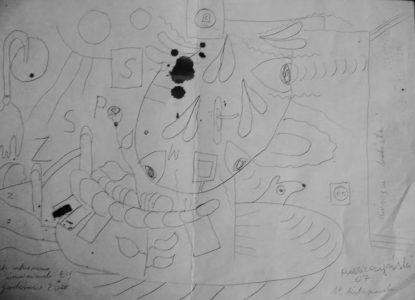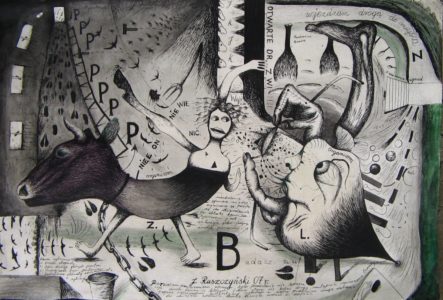Film made in July 2008 by the French film crew Poll Lemantais
O realizmie, obiektywizmie i uniwersalizmie w sztuce.
Realizm.
Nastawienie realistyczne można by scharakteryzować jako uznanie poza swoim “JA” otaczającej nas rzeczywistości. Wszechstronne jej poznanie można urzeczywistniać w formy plastyczne. Obrazowanie form, zestawianie ze sobą, analizowanie i zgłębianie pozwala nam zoriętować się w jaki sposób umysł działa, które formy rzeczywistości działają na nas, dlaczego te, a nie inne oraz w jaki sposób są przekształcane. Operowanie tego rodzaju twórczością wydaje się bardziej odpowiednim sposobem poznania rzeczywistości niż słowo, patrząc na otaczającą nas realność nie widzimy słów i znaczeń lecz obrazy, kształty, bryły, kolory, postacie etc.
Obiektywizm.
Łączy się ściśle z realizmem. To ta głęboko wyryta zasada i przeświadczenie, że w zdobywaniu poznawczym rzeczywistości “JA” jestem od niej zależny i muszę ją z trudem zdobywać, że nie jestem miarą i ośrodkiem świata. Zależność ta i zdobywanie poznawcze rzeczywistości, trud z tym związany wynika z szukania klucza, który pozwoliłby na konstrukcję teorii obrazowania rzeczywistości za pomocą form plastycznych. Wydaje się, że jest to możliwe. Należy jednak pamiętać, że działanie umysłu nie jest stałe lecz zmienne. Obrazy rzeczywistości w sposób ciągły przesuwają się przed nami w sposób ciągły, a zatrzymane obrazują poszczególne etapy działań, pozwalają cofnąć się w czasie i możemy zestawiając je ze sobą dokonać analizy psychoanalitycznej poszczególnych zatrzymań.
Uniwersalizm.
Uniwersalizm intelektu objawia się tym, że umysł celowo nie eliminuje ze swojej świadomości, ze swojego pola obserwacji i badań żadnego odłamu tej rzeczywistości, która jest mu dana; stara się jednym słowem uwzględnić wszystkie dane i nie przymykać oczu na żadne dziedziny. Oznacza to że świadomość jest podstawą, którą należy się kierować podczas tworzenia obrazu. Jeżeli te cechy uzupełnimy poczuciem głębokiej odpowiedzialności intelektu możemy być pewni, że intelekt ten dojdzie do prawdy.
np. Stefana Swieżawskiego.
Interview in Polish Radio Olsztyn
Jerzy Ruszczyński gave an interview for Polish Radio Olsztyn.
You can hear the whole audition in Polish under this address: Art of Jerzy Ruszczyński
A Man cutting a tree – 2019. Oil on cavas, 61×47 cm.
Group exhibition “Les Croqueurs d’Étoiles” in Montolieu, France has started!
I present my three paintings at the museum in Montolieu, France in a group exhibition called “Les Croqueurs d’Étoiles”. The exhibition has just started. You can see my work live at La Coopérative-Musée Cérès FRANCO, 5 Route d’Alzonne, 11170 Montolieu, France.
Jerzy Ruszczyński’s art at “Les Croqueurs d’Étoiles”
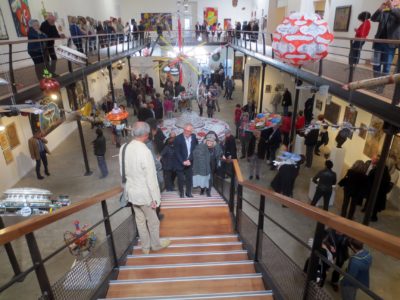
Reakcja wymuszona, działanie przyczynowo-skutkowe.
An article by Jeanine Rivais
Original text from an article about Jerzy Ruszczyński posted by a famous French art critic – Jeanine Rivais: Jerzy Ruszczyński in conflict with his most inhumain world
A fragment of the drawing from November 16, 2008.
Looking at the name-day at E – explanation
Explanation of the painting “Looking at the name-day at E”, 2007.
A fragment of the image, the upper part, the middle.
The central part of the image, fragment.
The sketch was made directly during the observed event, in the presence of E. and Z. and other organisms, objects and things that caused an influence on the overall composition and shape of the image. The letters marked in the sketch are omitted as a result of shifting the resulting image. A series of events from the moment the image was created to the final effect caused changes that were carried out twice. During the creative process, Mr. P. was introduced as an observer, why? It seems that the outcome of the decision would be to experience the impact of external reality. The influences that often have accidental sensations on us have their effect in the creative process. The continuous flow of images leaves traces in consciousness, the effect of which are subsequent creative decisions. The resulting from the flowing images probably draws so-called. intuition, but not entirely. Your contribution to intuitive creation also has what has been in us for a long time, i.e. the genesis of our formation. The involvement of intuition is quite difficult to be traced in each created image is a percentage different, and it all depends on the awareness of the attitude of own “I” to draw from its decks. To sum up, the picture in general character is a direct record of reality, it should be emphasized here the word “direct”, because it is a rarely used form due to the circumstances in which we come to stay, the more so that in fact there are also other direct shareholders of the image and having an impact on ourselves.



